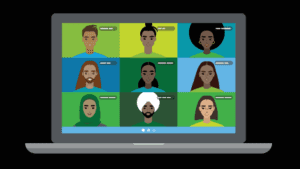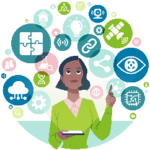The COVID-19 pandemic continues to have far-reaching impacts on all aspects of our lives. It’s driving organizations quickly into the future of work, ready or not. The critical need for social distancing forced organizations to adopt newer technologies and use old modalities in new ways. With classroom delivery not being an available option, many organizations scrambled to provide learning to either partially remote or entirely remote workforces.
Distance learning isn’t new, but the 2020 global pandemic and social distancing accelerated the shift to a more comprehensive and wide-spread transition to distance learning. Even curricula that organizations and educational institutions didn’t previously plan to convert to online learning — due to the nature or complexity of the content — transitioned to virtual delivery or totally asynchronous digital learning, driven by the necessity to continue work and workforce development.
This disruption is only going to continue. This new way of working and learning will likely never revert to our previous reliance on office and classroom environments. Even when the pandemic subsides, the ever-accelerating pace of change in technology and work will continue and new disruptions will occur. Organizations and their workforces need to focus on not only how to survive, but how to thrive in the face of disruption and continual change.
The 2021 Deloitte Global Human Capital Trends study “The Social Enterprise in a World Disrupted” focuses on workforce trends and insights to help organizations shift “from survive to thrive.” The study found that organizational success depends on the ability to become “distinctly human at its core.” In other words, enduring human capabilities are more critical than ever, and the workforce needs to be proficient in resiliency, agility, curiosity, creativity, empathy, courage and critical thinking.
A Deloitte Insights article published in June 2020, “Human inside: How capabilities can unleash business performance,” asserts that enduring human capabilities aren’t secondary to technical skills for organizations — they enable real business impact. To get there, leaders need to encourage greater application of human capabilities to the work of the organization, especially for front-line workers.
Deloitte’s research found that few organizations have focused on developing multiple capabilities across their organizations. A few organizations focused explicitly and most often on a single capability, and most organizations targeted only leaders and high-potential workers for development versus investing in building the learning ecosystem to develop the workforce at large. As a result, many workers don’t feel empowered to use their capabilities in their daily work. This is problematic because these human capabilities allow the workforce to flexibly adapt to ever-changing technology, newly required skills, and the shifting realities and challenges that come with new disruptions.
Learning organizations are being called upon to more successfully equip the workforce with these human capabilities despite the need for physical distance. Now that we have seen how learning organizations can broadly shift from the classroom to distance learning to accommodate the dispersed workforce, the question isn’t “Can we?” but rather, “How should we provide the best learning results and impact at a distance?”
Some capabilities, such as enduring human capabilities like resiliency, curiosity, creativity and empathy, don’t easily and automatically transition well to distance learning in the way that we traditionally think of and deploy it. To effectively provide the necessary capabilities for success both today and tomorrow, we need to go beyond traditional distance learning to create effective experiences that just happen to be distanced. It’s time for chief learning officers and learning organizations to move to a new approach, one we will call “learning distanced.”
Learning distanced flips not only the terminology, but the way of thinking into a new paradigm that focuses on learning first and the fact that it is physically distanced second. How can the concept of learning distanced help organizations provide the workforce with the capabilities needed to be successful both now and in the future?
The new paradigm requires moving from technology-driven learning to learning that is human-centered and oriented toward the new future of work. Organizations need to move thoughtfully from traditional approaches of distance learning to learning distanced as an essential capability to meet both mission and goals. CLOs and their teams need to refocus from technology as the driver to technology as an enabler of learning, secondary to focusing on the learner. Learning organizations need to transition from responding to learning risks to proactively managing risks. Learning organizations should also move beyond formal learning (i.e., courses delivered virtually or e-learning) to informal and experiential learning at a distance that emphasizes team and social learning as well as those competencies integral to future success.
Team and social learning are particularly important in these times of physical isolation. Belonging was one of the most important trends identified in Deloitte’s 2020 Global Human Capital Trends survey. Seventy-nine percent of survey respondents said that fostering a sense of belonging in the workforce was important to their organization’s success in the next 12-18 months, and 93 percent agreed that a sense of belonging drives organizational performance.
Previous organizational efforts to foster belonging have primarily focused on making every individual feel respected and treated fairly in an inclusive work environment. While this remains critical, the Global Human Capital Trends survey also found that leading organizations are forging a stronger link between belonging and organizational performance by strengthening workers’ connections with their teams and fostering their sense of contribution to meaningful shared goals. A learning distanced approach increases the focus on the social connections created during learning experiences regardless of the physical distance between participants.
So how can your organization make this transition from distance learning to learning distanced and develop the right workforce for today and tomorrow? Here are some suggestions to guide your journey.
- Learner focus and engagement: Using the right technology with robust features to support active learner engagement is important, but not enough. The learning distanced experience needs to be designed with the learner at the forefront, u
 sing both human-centered design and learning design best practices. The effective design of learning distanced gives the learner frequent opportunities to apply learned knowledge and skills with abundant and timely feedback built in. The learning organization can also improve learner engagement by moving from a “push” approach to a “pull” approach that allows learners to explore and drive their own learning. Providing more choices in learning and a focus on learner needs and interests can stimulate curiosity, increase learner engagement and encourage lifelong learning. Even with a pull approach, learning organizations can still guide and enable learners to make the right learning choices for themselves. Learners who aren’t focused on learning aren’t engaged and won’t benefit from the learning. To address this and the additional challenges that workforces face while working from home, organizations can provide support, such as no-meeting days and dedicated blocks of training time, to reduce the disruptions and distractions that negatively impact learner attention, engagement and learning.
sing both human-centered design and learning design best practices. The effective design of learning distanced gives the learner frequent opportunities to apply learned knowledge and skills with abundant and timely feedback built in. The learning organization can also improve learner engagement by moving from a “push” approach to a “pull” approach that allows learners to explore and drive their own learning. Providing more choices in learning and a focus on learner needs and interests can stimulate curiosity, increase learner engagement and encourage lifelong learning. Even with a pull approach, learning organizations can still guide and enable learners to make the right learning choices for themselves. Learners who aren’t focused on learning aren’t engaged and won’t benefit from the learning. To address this and the additional challenges that workforces face while working from home, organizations can provide support, such as no-meeting days and dedicated blocks of training time, to reduce the disruptions and distractions that negatively impact learner attention, engagement and learning.
- Social connections: The increased reliance of organizations on teams demands improved team and social learning. In times of physical distancing and remote work, we need to leverage the social connections that formal and informal learning can provide. Social connection drives greater collaboration and helps create the human connection and personal well-being
 necessary for work and learning to be most effective. Learning organizations should increase learner involvement with more peer-to-peer interactions and team-building opportunities in the design of learning activities. CLOs and their teams should look for opportunities to use learning as a mechanism to strengthen relationships and drive social connections to overcome the isolating effect of distance during remote learning and work. Remember that physical distancing doesn’t need nor require social distancing — those social connections can still be an integral part of work and life while physically apart. Consider establishing new “virtual water cooler” learning environments to informally share experiences and tacit knowledge.
necessary for work and learning to be most effective. Learning organizations should increase learner involvement with more peer-to-peer interactions and team-building opportunities in the design of learning activities. CLOs and their teams should look for opportunities to use learning as a mechanism to strengthen relationships and drive social connections to overcome the isolating effect of distance during remote learning and work. Remember that physical distancing doesn’t need nor require social distancing — those social connections can still be an integral part of work and life while physically apart. Consider establishing new “virtual water cooler” learning environments to informally share experiences and tacit knowledge.
 Learning agility: In disruptive environments, learning organizations that have moved quickly and flexibly have reduced the negative impacts of the disruptions. Learning system requirements that best meet current needs must be rapidly identified and resourced. Agile learning development processes contribute to the nimble design, development and delivery of multiple flexible modalities and learning technology architectures, which in turn can help achieve the right learning outcomes. Learners, learning providers and learning systems must be able to change and adapt at least as fast as disruptions demand. Agile, flexible governance processes, as well as change-management efforts, are essential to support a changing and ever-evolving and learning workforce.
Learning agility: In disruptive environments, learning organizations that have moved quickly and flexibly have reduced the negative impacts of the disruptions. Learning system requirements that best meet current needs must be rapidly identified and resourced. Agile learning development processes contribute to the nimble design, development and delivery of multiple flexible modalities and learning technology architectures, which in turn can help achieve the right learning outcomes. Learners, learning providers and learning systems must be able to change and adapt at least as fast as disruptions demand. Agile, flexible governance processes, as well as change-management efforts, are essential to support a changing and ever-evolving and learning workforce.
- Enabling technology: Remember to lead with the learner, not the technology. In addition to new, virtual synchronous delivery options and digital collaboration tools, there are many emerging options with potential — for example, artificial int
 elligence, which is being used to better understand worker competencies and organizational development areas. Virtual reality is another example, helping learners build soft skills and practice difficult interpersonal situations without the risk of damaging actual relationships. The key is to adapt the technology to the learner, and not force the learner to adjust to the wrong technology. There are so many technologies available to support learning at a distance, and some are better than others. Thoughtfully select the right technology for the learner and desired learning outcomes by assessing not only what technology to use but how the technology will be used.
elligence, which is being used to better understand worker competencies and organizational development areas. Virtual reality is another example, helping learners build soft skills and practice difficult interpersonal situations without the risk of damaging actual relationships. The key is to adapt the technology to the learner, and not force the learner to adjust to the wrong technology. There are so many technologies available to support learning at a distance, and some are better than others. Thoughtfully select the right technology for the learner and desired learning outcomes by assessing not only what technology to use but how the technology will be used.
- Content curation and knowledge management: We have moved from scarcity of knowledge to an overabundance of knowledge, which creates interesting challenges. A learner has quick and easy access to large volumes of information, making content relevance and lack of customization major stumbling blocks. Learners need the ability to
 quickly access the right content at the right time and for the right purpose. Learning at a distance calls for the additional digitization of learning content that is available remotely. While digitized content can be more easily leveraged and applied, remember that effective curation requires understanding learner needs in remote environments and the potentially new requirements based on remote work. Providing learning content in the flow of work is a real learning and productivity enhancement.
quickly access the right content at the right time and for the right purpose. Learning at a distance calls for the additional digitization of learning content that is available remotely. While digitized content can be more easily leveraged and applied, remember that effective curation requires understanding learner needs in remote environments and the potentially new requirements based on remote work. Providing learning content in the flow of work is a real learning and productivity enhancement.
For your organization, which comes first — distance or learning? If it’s still distance learning, what’s your strategy to move from distance learning to a focus on learning distanced? How can you take advantage of disruption to help your workforce and organization thrive? Your transformation might start with a plan and then focus on developing a culture of agility and innovation, building emotional and social connections, leveraging the right technology, and connecting “learning at a distance” with “working at a distance.”
Properly implemented and supported, a learning distanced approach can lead to more engaged learners, better learning outcomes, reduced training risk, and a workforce that is prepared to thrive during disruptions now and in the future.















